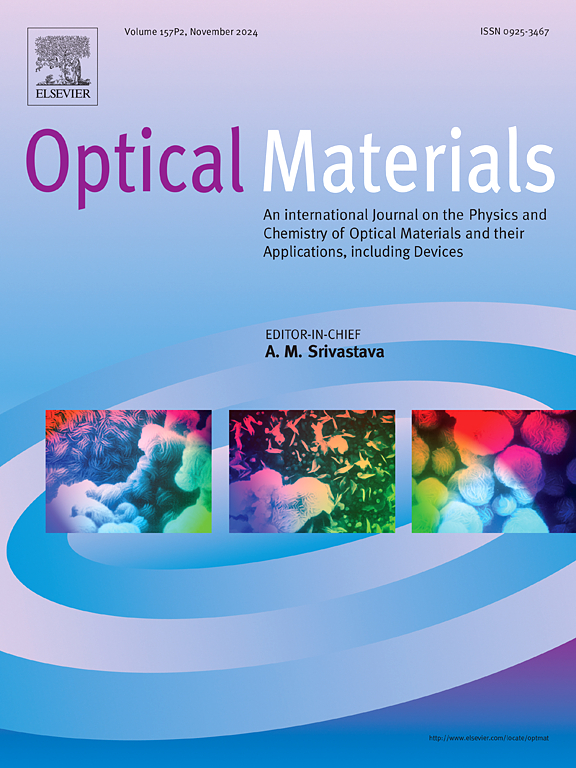Defect states assisted optical nonlinearity of metal nanoparticle incorporated 2D graphene-MoS2 nanocomposites for engineered photonic device applications
IF 3.8
3区 材料科学
Q2 MATERIALS SCIENCE, MULTIDISCIPLINARY
引用次数: 0
Abstract
Advanced nonlinear materials are engineered with tailored structural, physical and chemical properties to address modern technological demands exhibiting multifunctional potentiality. Here the synergistic behaviour of copper nanoparticles decorated reduced graphene oxide-Molybdenum disulfide (Cu@rGO-MoS2) hybrid was assessed to estimate the influence of defect states on the nonlinear optical absorption behaviour under intense nanosecond laser excitation. Cu@rGO-MoS2 hybrids, prepared by hydrothermal synthesis with different concentration of Cu was preliminarily characterized by X-ray diffraction, X-ray photoelectron spectroscopy and Raman spectroscopy analysis. The rGO layer stacking upon MoS2 nanosheets with hexagonal structure, chemical states of all the counterparts, few layer MoS2 in the hybrid, successful reduction of graphene oxide and fingerprint vibrational bands were confirmed. The scanning electron microscopy images showcased MoS2 as spherical structure and rGO as layers with Cu initially as dots grow and form wires/rods of varying length and width with increasing Cu concentration in the hybrids. Altogether, the preliminary characteristics probed the presence of enhanced defect states in all the hybrids. The availability of complex sub bandgap states for new pathways in the electronic transition were confirmed using linear ground state absorption analysis. The nonlinear absorption studies were carried out by performing open aperture Z-scan analysis using a Q-switched Nd:YAG laser (532 nm, 10 Hz and 9 ns). All the open aperture Z-scan pattern depicted reverse saturable absorption (RSA) behaviour at all the input on-axis intensities. The RSA was attributed to the sequential two photon absorption mechanism which was underpinned by the intensity dependent Z-scan studies. The carrier dynamics, field enhancements effects, large active surface region, broad light absorption and induced more defects with inclusion of Cu nanoparticles has effectively influenced the nonlinear optical absorption behaviour by tuning the electronic structure making provisions for utilizing the Cu@rGO-MoS2 hybrid as an efficient optical limiter for laser safety.

二维石墨烯-二硫化钼纳米复合材料在工程光子器件中的应用
先进的非线性材料具有定制的结构,物理和化学特性,以满足现代技术需求,展示多功能潜力。本文研究了铜纳米粒子修饰的还原氧化石墨烯-二硫化钼(Cu@rGO-MoS2)杂化物的协同行为,以评估缺陷态对强纳秒激光激发下非线性光学吸收行为的影响。通过x射线衍射、x射线光电子能谱和拉曼光谱分析对不同Cu浓度水热合成的Cu@rGO-MoS2杂化体进行了初步表征。证实了氧化石墨烯层在MoS2纳米片上呈六角形堆积,所有对应物的化学状态,杂化层中MoS2较少,氧化石墨烯的成功还原和指纹振动带。扫描电镜图像显示,MoS2为球形结构,而氧化石墨烯(rGO)最初为含Cu层,随着点的生长,随着铜浓度的增加,形成了不同长度和宽度的线/棒。综上所述,这些初步特征表明所有杂化体都存在缺陷态增强。利用线性基态吸收分析证实了复合子带隙态在电子跃迁新途径中的可用性。利用调q Nd:YAG激光器(532 nm, 10 Hz, 9 ns)进行开孔z扫描分析,研究了非线性吸收。在所有输入轴上强度下,所有开放孔径z扫描模式都描述了反向饱和吸收(RSA)行为。RSA归因于序列双光子吸收机制,该机制得到了强度相关z扫描研究的支持。载流子动力学、场增强效应、大的活性表面积、广泛的光吸收以及Cu纳米颗粒包合引起的更多缺陷通过调整电子结构有效地影响了非线性光吸收行为,为利用Cu@rGO-MoS2杂化材料作为激光安全的有效光限制器提供了条件。
本文章由计算机程序翻译,如有差异,请以英文原文为准。
求助全文
约1分钟内获得全文
求助全文
来源期刊

Optical Materials
工程技术-材料科学:综合
CiteScore
6.60
自引率
12.80%
发文量
1265
审稿时长
38 days
期刊介绍:
Optical Materials has an open access mirror journal Optical Materials: X, sharing the same aims and scope, editorial team, submission system and rigorous peer review.
The purpose of Optical Materials is to provide a means of communication and technology transfer between researchers who are interested in materials for potential device applications. The journal publishes original papers and review articles on the design, synthesis, characterisation and applications of optical materials.
OPTICAL MATERIALS focuses on:
• Optical Properties of Material Systems;
• The Materials Aspects of Optical Phenomena;
• The Materials Aspects of Devices and Applications.
Authors can submit separate research elements describing their data to Data in Brief and methods to Methods X.
 求助内容:
求助内容: 应助结果提醒方式:
应助结果提醒方式:


